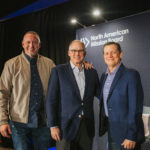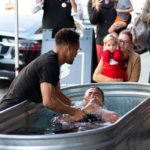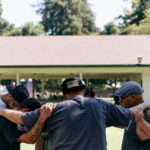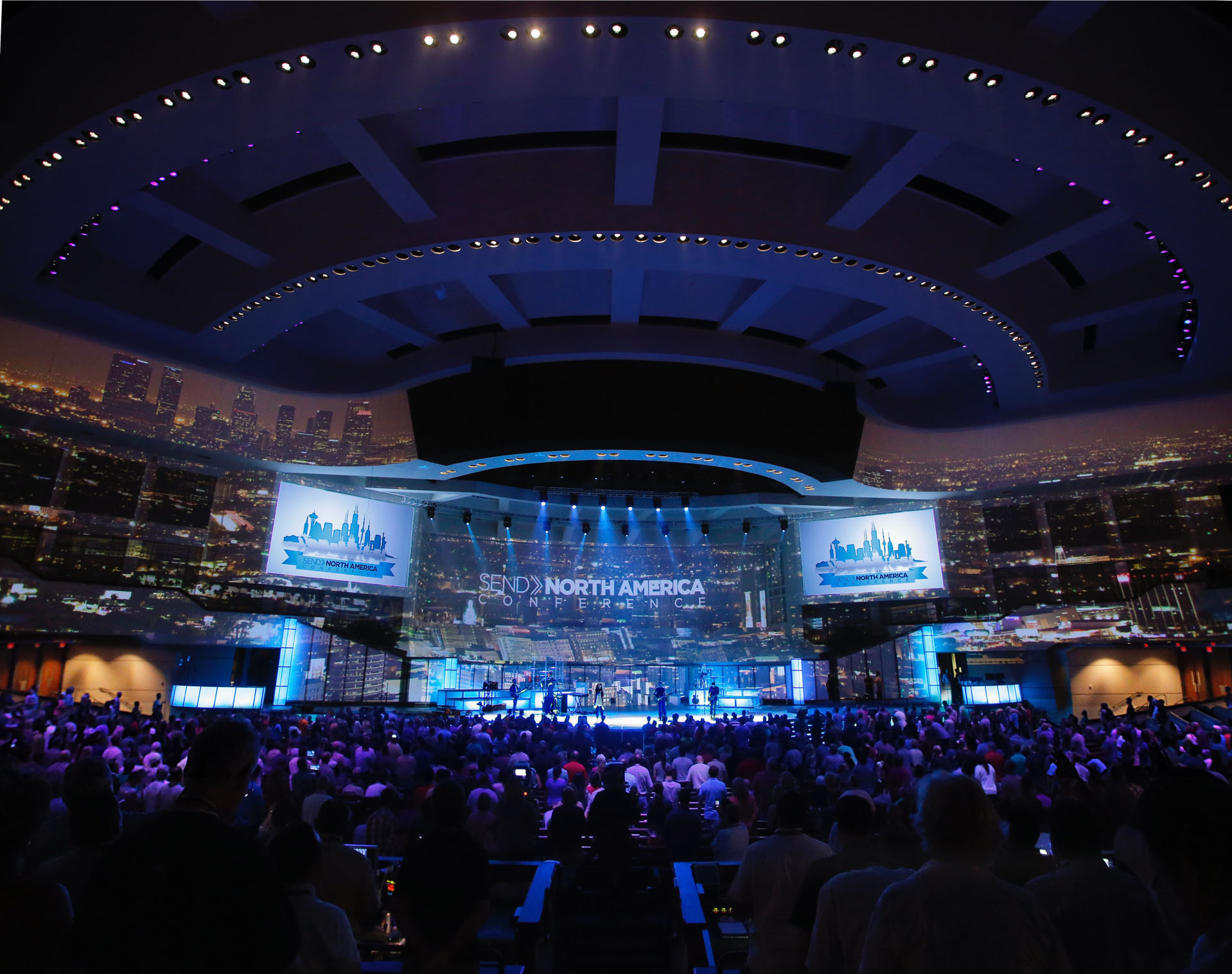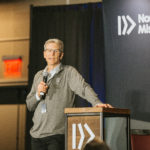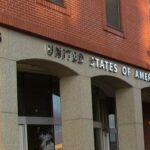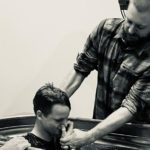 [1]
[1]NASHVILLE (BP) – “It’s working,” North American Mission Board (NAMB) President Kevin Ezell said of NAMB’s strategy for reaching North America with the Gospel. Since 2010, Southern Baptists have planted more than 8,200 churches.
As Ezell shared that number, a map of North America depicted the success with dots representing where churches have been planted over the last decade.
Those churches, Ezell said, make up nearly 17 percent of all churches across the Southern Baptist Convention. Outside the South, church plants represent nearly 19 percent of all reported baptisms in the SBC.
In Canada, 54 percent of all current Baptist churches were planted since 2010, and more than half of the baptisms reported in Canada came from those churches.
“At the North American Mission Board, everything we do is all about the Gospel,” Ezell said to open his presentation. “The Gospel is pre-eminent, and the Gospel unites.”
Ezell laid out the vision NAMB has implemented to share the Gospel across North America through what he described as “a single, simple vision.”
“Plant churches to reach broken people – that’s Send Network. Transform communities through compassion ministry – that’s Send Relief,” Ezell said. “And restore our neighbors through the power of the Gospel – that’s Evangelism.”
Every dot on the map, Ezell pointed out, represented a face, the face of a church planting missionary. He showed portraits of church planters in Puerto Rico who represented 16 churches planted since 2016.
Puerto Rico “is a place where no SBC churches were planted in some 20 years,” Ezell said.
In Quebec, Ezell discussed David Pothier, who started La Chapelle in Montréal. In April of 2021, his church baptized 17 people.
“Since David Pothier started that church in 2013,” Ezell said, “they have baptized 649 people, and have partnered with NAMB to plant four churches so far, with one more coming soon.”
After reporting the success Southern Baptists have experienced through church planting, Ezell pointed out the need that remained.
“There is a compelling need, but the need is as great today if not greater than it was a decade ago,” Ezell said. “Clearly, there is more work to be done, but let’s remember, NAMB doesn’t plant churches. Churches plant churches.”
The biggest challenge is the need for more qualified church planters, and NAMB aims to equip Southern Baptist churches. Recently, NAMB announced the launch of a resources and research group that will provide material to churches for free.
“We can and will continue with efforts like this work to equip planters, but the bottom line is that planters come from churches,” Ezell said. “They come from big churches, small churches, urban centers, suburbia and small towns.”
Southern Baptists planted 588 churches, saw 143 new churches affiliate with the SBC and 126 new church campuses started in 2020. In total, 857 new Southern Baptist congregations were added.
Of those churches planted, 60 percent were ethnic or multiethnic congregations, and Send Network recently completed the translation of all church planter-related materials into Spanish to better serve and contextualize for Spanish-speaking missionaries.
“Our focus is less about yearly counts, quite honestly,” Ezell said. “It’s more about equipping those churches planted to start strong, evangelistic, healthy churches, and right now 80 percent of our churches are still active after 4 years. That’s the target.”
Ezell thanked Southern Baptists on behalf of North American church planters for their faithful giving of $49.5 million to the Annie Armstrong Easter Offering, a substantial amount given that COVID-19 hit during the season when Southern Baptists typically give to the offering.
As a part of his emphasis on the importance of one, Ezell shared the story of Chris Carrier, a man who was left for dead as a young boy after his assailant kidnapped and shot him through the head.
After six days of lying unconscious in the Everglades, Carrier was discovered and eventually recovered, and as an adult, he had the opportunity to lead his assailant to Christ as the man was on his deathbed.
When asked about what it was like to speak and pray with his assailant, Carrier had one word for it: “Awkward.”
“It was simply two men in the awkwardness of our reunion and newfound friendship, seeking the grace and the presence of God in that room,” Carrier said.
Before Ezell’s report, Johnny Hunt, NAMB’s senior vice president for evangelism and leadership, shared a report on Crossover and the results of the evangelism movement called Who’s Your One.
During the Crossover week of evangelistic outreach leading up to the annual meeting in Nashville, volunteers reported 6,300 gospel conversations and 176 salvations.
Across 27 Who’s Your One Tour stops, more than 13,000 people have attended the Sunday night rallies while more than 5,000 attended the Monday morning evangelism trainings.
“I joined the North American Mission Board two years ago, and I’ve found evangelism to be at the heart of everything we do,” Hunt said. “I’m grateful to God for the Christ-honoring leadership of our president, Kevin Ezell. Whether it is through Send Relief, Send Network, evangelism or pastoral leadership, it’s all about the Gospel.”
Questions and answers
Following the presentation and report, the floor was opened for messengers to the SBC Annual Meeting to ask questions of Ezell and NAMB.
The first question came from Joey Hufstedler, messenger and pastor from Poplar Grove Baptist Church in Trenton, Tenn., who asked to see NAMB’s salary structure. Since the question related to NAMB salaries, Ezell referred the response to NAMB trustee chairman, Eric Thomas, senior pastor of First Baptist Church of Norfolk, Va.
“The North American Mission Board, the board of trustees, has established appropriate procedures for limited access to compensation information,” Thomas said. “And we will respond to any questions for such information on a case-by-case basis.”
Dave Van Bebber, messenger and pastor of First Baptist Church Buffalo, Mo., asked about whether NAMB training material included information about the “immediate abolition of abortion without exception or compromise.”
Ezell stated that he was against abortion and that NAMB trains and equips planters in the areas of theology and application in church planting. Ezell also said that abortion was not specifically mentioned in training material. NAMB-endorsed planters are, however, required to embrace the Baptist Faith and Message 2000 which includes language supporting the protection of unborn human life.
A final question came from Jon Bullock, a messenger who serves on staff at The Island Chapel in Tierra Verde, Fla., pastored by Will McRaney, who asked about money spent in lobbying the federal government on behalf of Send Relief.
Ezell stated that he could not recall specific details at the moment. However, that information is provided below in a statement from NAMB:
The role of local, state and federal governments is critical to disaster response and coordination. This is especially true with the role of FEMA.
As FEMA continued to push more regulation on which organizations could participate in recovery efforts, Send Relief spent an average of $149,000 per year for four years on consulting support from The Nickles Group in Washington, D.C. This was to further perfect NAMB’s communication and work with federal officials and members of Congress as they, and we, sought to serve those impacted by storms, tornadoes, floods and earthquakes.
One of the many results was a Memorandum of Understanding which formalized the relationship between Send Relief and FEMA, allowing NAMB to have appropriate representation at the National Response Control Center (NRCC) during ongoing crises. Without such representation, Southern Baptists would not have been able to gain immediate access to partner organizations to do ministry during natural disasters.
In addition, we were successful in helping to change the nation’s disaster law, which now allows FEMA to work directly with an expanded group of non-profit disaster organizations, like Send Relief and Southern Baptist Disaster Relief.
This relationship also helped bring heightened attention to and expand NAMB’s disaster recovery ministry in Puerto Rico, where Send Relief was one of the largest partners in FEMA’s Valor program. Through Valor, FEMA provided roofing materials and Send Relief provided volunteers to repair homes ravaged by storms and earthquakes on the island. This program, plus other in-kind donations, generated more than $1 million in support for the people of Puerto Rico, allowing Southern Baptists to effectively expand the reach of their compassion ministry and giving through the Cooperative Program. Through this work, NAMB was able to support 2,300 people with more habitable homes. More broadly, Send Relief met the needs of more than 24,000 people, and that relief work continues today.
The Nickles Group did register as a lobbying firm on behalf of Send Relief, to ensure all parties followed the letter of the disclosure requirements. However, they helped NAMB navigate the government, not lobby it, as we sought to serve well.
Now with even stronger relationships and response strategies, we no longer need the services of an outside firm, and we are confident in our ability to navigate public agencies and resources for disaster response.



